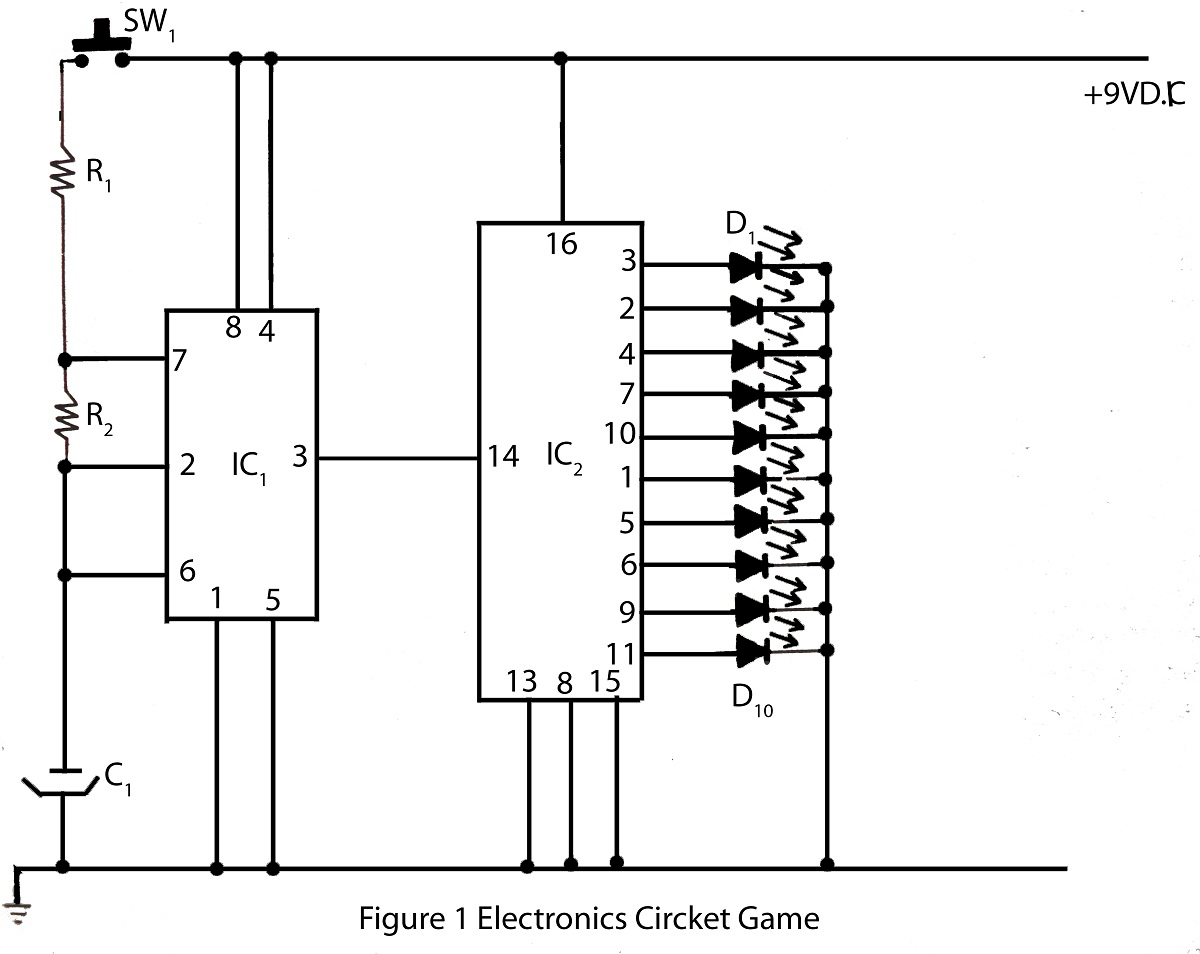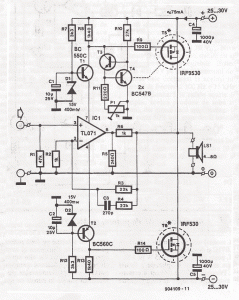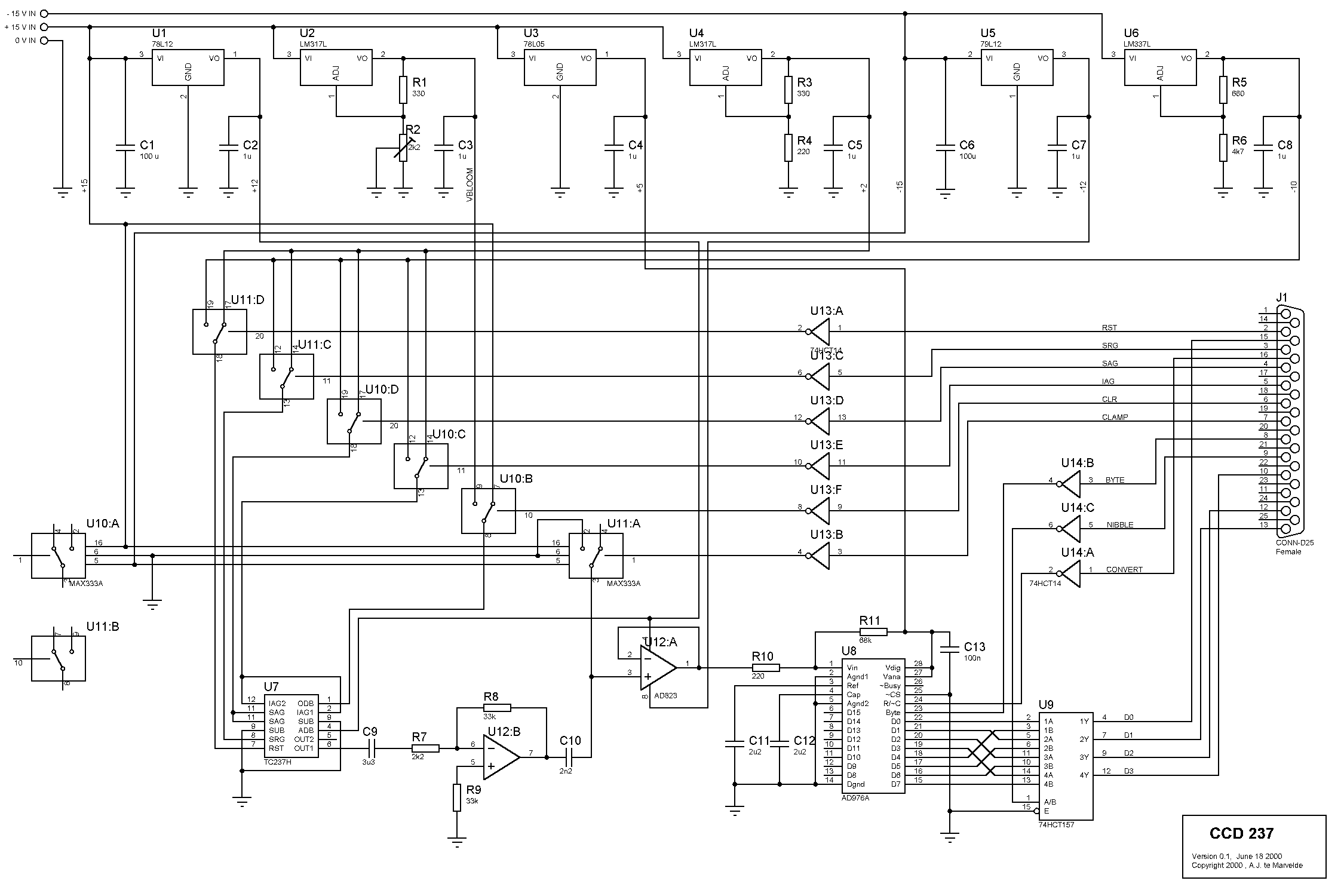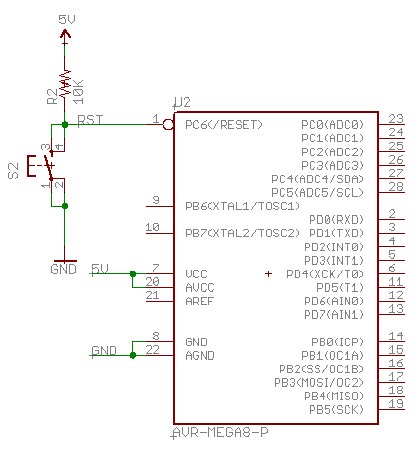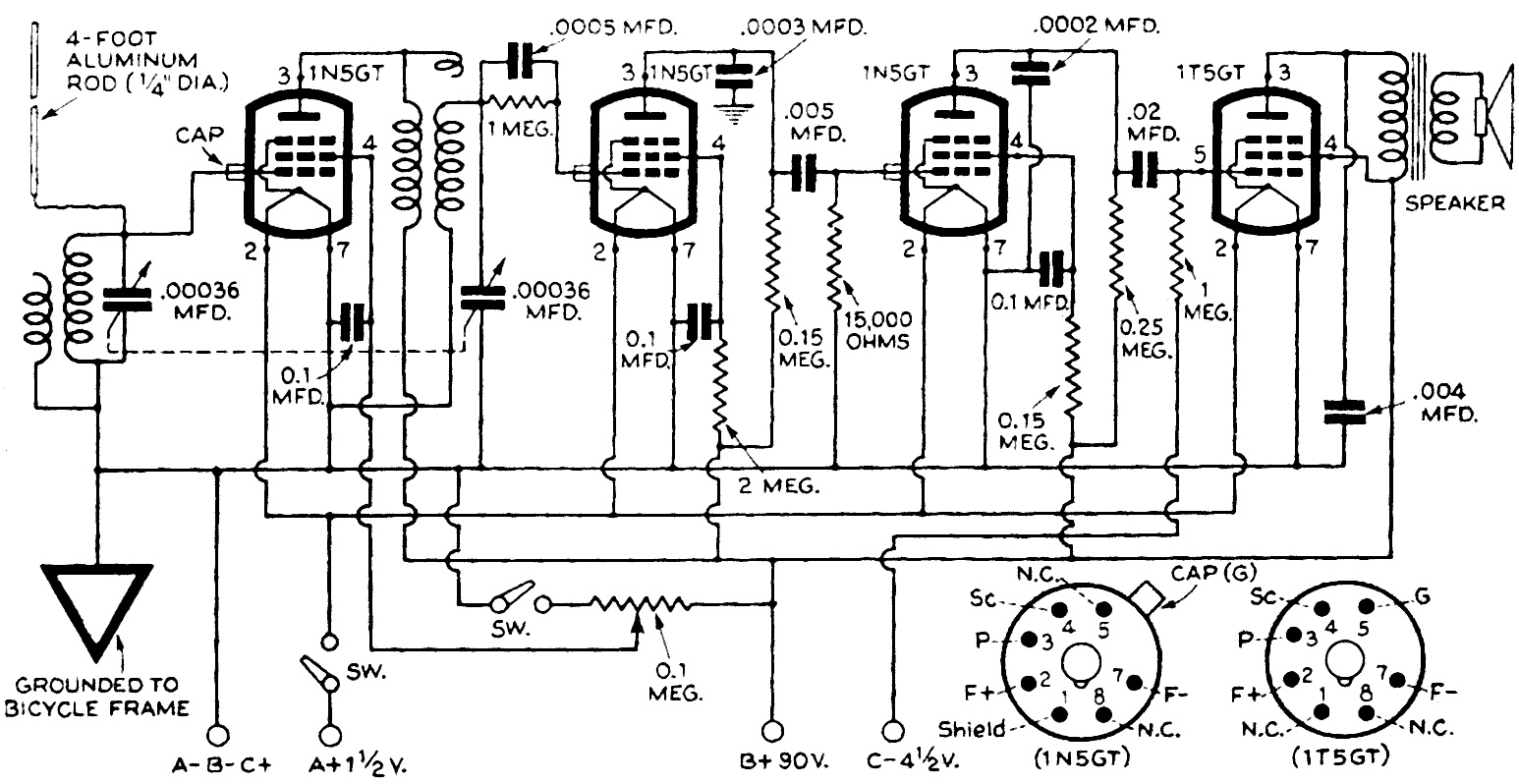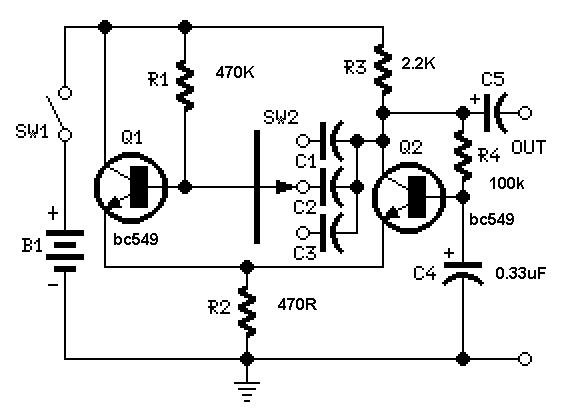
Popular Electronics Magazine April 1955
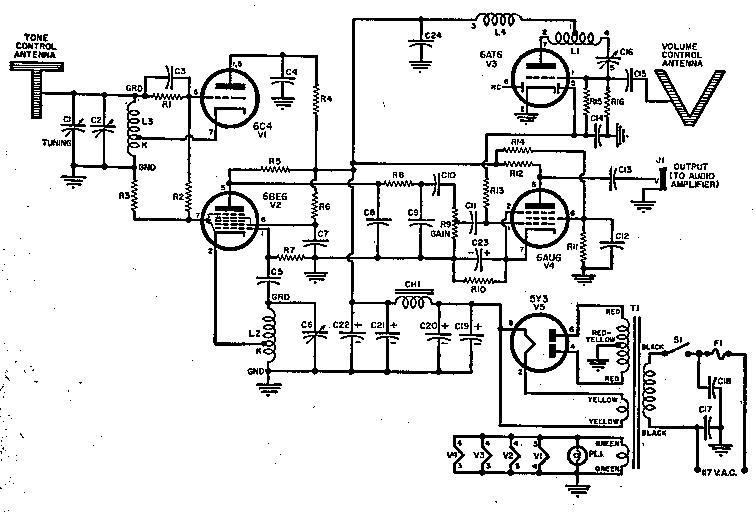
The April 1955 issue of Popular Electronics magazine features a cover illustration of a gentleman playing a homebuilt Theremin. Theremins are among the earliest electronic musical instruments, invented in the 1920s by Russian inventor Leon Theremin. The instrument is unique in that it allows musicians to play without physical contact; pitch and volume are controlled by moving hands in proximity to two antennas. The magazine includes plans for constructing a Theremin using five vacuum tubes (5Y3GT, 6AU6, 6AT6, 6BE6, 6C4) and a transformer-type power supply, housed in a standard 1950s amplifier chassis. The antennas are designed as simple loops or poles, with large sheet-metal letters "T" for tone and "V" for volume. The operation involves a variable frequency RF oscillator (6C4) combined with a fixed frequency RF oscillator in the mixer stage (6BE6). The resulting audio frequency output passes through a filter to eliminate residual RF signals before reaching a variable gain amplifier (6AU6). The gain of the 6AU6 is influenced by a third high-frequency oscillator (6AT6). One antenna adjusts the frequency of the 6C4 oscillator, affecting the pitch, while the other antenna modifies the output of the 6AT6 oscillator, influencing the volume. By varying the distance from the antennas, the musician alters the capacitive coupling, enabling the production of different notes. Additional Theremin designs were published in the 1950s and 1960s, including a five-tube version in the January 1961 issue of Electronics Illustrated and a solid-state version called the Lumemin in the January 1966 issue of Popular Electronics. Playing the Theremin is notoriously challenging, with few mastering it to a concert level. Contrary to popular belief, the Beach Boys used an Electro-Theremin in "Good Vibrations," not a traditional Theremin. The instrument has featured in film scores, notably in "The Day the Earth Stood Still" and "Spellbound." Interest in the Theremin has surged in recent years, with documentaries and music collections available for purchase.
The Theremin operates on the principle of heterodyning, where two radio frequency signals are mixed to produce an audible output. In this design, the 6C4 tube functions as a variable frequency oscillator, generating a signal whose frequency can be altered by the proximity of the musician's hands to the tone control antenna. The second oscillator, represented by the 6AT6 tube, operates at a fixed frequency and is modulated by the volume control antenna. The mixer stage, utilizing the 6BE6 tube, combines these two signals, producing a difference frequency that corresponds to the desired audio pitch.
The output from the mixer is filtered to remove any unwanted RF components, ensuring that only the audio frequency is amplified. The variable gain amplifier stage (6AU6) allows for dynamic control of the output volume, influenced by the grid bias set by the high-frequency oscillator (6AT6). This configuration provides a highly interactive playing experience, where the musician's gestures directly influence both the pitch and volume of the sound produced.
The construction of the Theremin involves careful attention to the layout of components on the chassis, ensuring minimal interference and optimal performance. The use of a transformer-type power supply is essential for providing the necessary voltages to the various tube stages, while the choice of tubes impacts the tonal characteristics of the instrument. The antennas, which are fundamental to the operation of the Theremin, should be positioned to allow for maximum sensitivity to the player's movements.
Overall, the Theremin represents a fascinating intersection of electronics and music, with its unique method of sound production and expressive potential. As interest in electronic music continues to grow, the Theremin remains a captivating instrument for both musicians and enthusiasts alike.When I spotted this April, 1955 issue of Popular Electronics magazine at a swap meet, I practically left burning rubber on the floor as I rushed over to grab it. Theremins have always interested me, and I had been seeking this issue for a long time after spotting one (ovepriced!) in an online auction.
The cover depicts a dreamy-looking gent playin g his homebuilt Theremin. Theremins were among the very earliest electronic musical instruments. Invented in the 1920s by a Russian, Leon Theremin, this namesake instrument is played without any physical contact between the musician and the device! You merely move your hands in the air near two antennas to control the Theremin`s pitch and volume. The magazine contains plans for building this Theremin. Using five tubes (5Y3GT, 6AU6, 6AT6, 6BE6, 6C4), the device uses a transformer-type power supply and and is constructed using a standard 1950s amplifier chassis and housing.
Most Theremin antennas take the shape of simple loops or poles. In this design, the antennas are terminated with large sheet-metal letters, T for tone and V for volume. Below is the schematic and basic technical description. In operation, the signals from a variable frequency RF oscillator (the 6C4 stage) are combined with the signals from a fixed frequency RF oscillator in the mixer stage (6BE6).
The difference frequency output, an audio frequency, is fed through a filter circuit to remove any RF signals that might remain and then to a variable gain amplifier (6AU6). The amount of amplification given by the 6AU6 stage depends on its grid bias and this, in turn, depends on the output of a third high frequency oscillator (6AT6).
One antenna permits the operator to vary the frequency of the 6C4 oscillator ("T" or tone control antenna) and hence the pitch of the note produced. Another antenna permits the operator to vary the output of the 6AT6 oscillator ("V" or volume control antenna) and hence the loudness of the note.
By moving his hands closer to and away from the two antennas, the musician changes capacities to ground in the two oscillators, and can play any note desired. Many other Theremin designs were published in the 1950s and 1960s. My article about the January, 1961 Electronics Illustrated has complete plans for a five-tube Theremin similar to this one (no custom coil winding required).
The August, 1962 issue of Popular Electronics shows how to convert an inexpensive five-tube radio into a Theremin. The January, 1966 issue of Popular Electronics shows plans for a solid-state version dubbed the Lumemin, which substitutes photocells for the antennas.
A Theremin is fiendishly hard to play and few people other than Rockmore ever mastered it sufficiently to play at the concert level. I have tried playing restored RCA Theremins at a museum in San Francisco and at the Spark Museum of Electrical Invention in Bellingham, Washington, and I can testify to the difficulty.
With nothing to guide or rest your hands on, it`s tricky even to hold a simple, clear note! Contrary to popular belief, the Beach Boys did not use a Theremin in their song "Good Vibrations. " The device used was an Electro-Theremin, an obscure instrument based on an audio oscillator. Theremin music figured prominently in the sound tracks of films, including The Day the Earth Stood Still, starring Michael Rennie, and Spellbound, starring Ingrid Bergman and Gregory Peck and featuring a score by Miklos Rosza. Interest in the Theremin has grown during the last decade. The 1990s documentary film, Theremin: An Electronic Odyssey, told the story of Leon Theremin. You can also buy CD collections of Theremin music. The Art of the Theremin, released by Delos, contains twelve performances by Clara Rockmore herself. You can even buy the complete soundtrack of The Day the Earth Stood Still. All of these items are available from amazon. com and other retailers. Elsewhere in our Literature section, you`ll find the January, 1961 issue of Electronics Illustrated magazine, which contains plans for building another tube Theremin.
In 2013, I was contacted by Craig Hanson, who had built a Theremin following that design. The photo shows Craig`s Theremin in a custom cabinet: In his article in our Building section, Craig explains how he successfully completed this project. Congratulations, Craig! If anyone else builds a Theremin using either the 1955 or 1961 plans, kindly contact me via email. 🔗 External reference
The Theremin operates on the principle of heterodyning, where two radio frequency signals are mixed to produce an audible output. In this design, the 6C4 tube functions as a variable frequency oscillator, generating a signal whose frequency can be altered by the proximity of the musician's hands to the tone control antenna. The second oscillator, represented by the 6AT6 tube, operates at a fixed frequency and is modulated by the volume control antenna. The mixer stage, utilizing the 6BE6 tube, combines these two signals, producing a difference frequency that corresponds to the desired audio pitch.
The output from the mixer is filtered to remove any unwanted RF components, ensuring that only the audio frequency is amplified. The variable gain amplifier stage (6AU6) allows for dynamic control of the output volume, influenced by the grid bias set by the high-frequency oscillator (6AT6). This configuration provides a highly interactive playing experience, where the musician's gestures directly influence both the pitch and volume of the sound produced.
The construction of the Theremin involves careful attention to the layout of components on the chassis, ensuring minimal interference and optimal performance. The use of a transformer-type power supply is essential for providing the necessary voltages to the various tube stages, while the choice of tubes impacts the tonal characteristics of the instrument. The antennas, which are fundamental to the operation of the Theremin, should be positioned to allow for maximum sensitivity to the player's movements.
Overall, the Theremin represents a fascinating intersection of electronics and music, with its unique method of sound production and expressive potential. As interest in electronic music continues to grow, the Theremin remains a captivating instrument for both musicians and enthusiasts alike.When I spotted this April, 1955 issue of Popular Electronics magazine at a swap meet, I practically left burning rubber on the floor as I rushed over to grab it. Theremins have always interested me, and I had been seeking this issue for a long time after spotting one (ovepriced!) in an online auction.
The cover depicts a dreamy-looking gent playin g his homebuilt Theremin. Theremins were among the very earliest electronic musical instruments. Invented in the 1920s by a Russian, Leon Theremin, this namesake instrument is played without any physical contact between the musician and the device! You merely move your hands in the air near two antennas to control the Theremin`s pitch and volume. The magazine contains plans for building this Theremin. Using five tubes (5Y3GT, 6AU6, 6AT6, 6BE6, 6C4), the device uses a transformer-type power supply and and is constructed using a standard 1950s amplifier chassis and housing.
Most Theremin antennas take the shape of simple loops or poles. In this design, the antennas are terminated with large sheet-metal letters, T for tone and V for volume. Below is the schematic and basic technical description. In operation, the signals from a variable frequency RF oscillator (the 6C4 stage) are combined with the signals from a fixed frequency RF oscillator in the mixer stage (6BE6).
The difference frequency output, an audio frequency, is fed through a filter circuit to remove any RF signals that might remain and then to a variable gain amplifier (6AU6). The amount of amplification given by the 6AU6 stage depends on its grid bias and this, in turn, depends on the output of a third high frequency oscillator (6AT6).
One antenna permits the operator to vary the frequency of the 6C4 oscillator ("T" or tone control antenna) and hence the pitch of the note produced. Another antenna permits the operator to vary the output of the 6AT6 oscillator ("V" or volume control antenna) and hence the loudness of the note.
By moving his hands closer to and away from the two antennas, the musician changes capacities to ground in the two oscillators, and can play any note desired. Many other Theremin designs were published in the 1950s and 1960s. My article about the January, 1961 Electronics Illustrated has complete plans for a five-tube Theremin similar to this one (no custom coil winding required).
The August, 1962 issue of Popular Electronics shows how to convert an inexpensive five-tube radio into a Theremin. The January, 1966 issue of Popular Electronics shows plans for a solid-state version dubbed the Lumemin, which substitutes photocells for the antennas.
A Theremin is fiendishly hard to play and few people other than Rockmore ever mastered it sufficiently to play at the concert level. I have tried playing restored RCA Theremins at a museum in San Francisco and at the Spark Museum of Electrical Invention in Bellingham, Washington, and I can testify to the difficulty.
With nothing to guide or rest your hands on, it`s tricky even to hold a simple, clear note! Contrary to popular belief, the Beach Boys did not use a Theremin in their song "Good Vibrations. " The device used was an Electro-Theremin, an obscure instrument based on an audio oscillator. Theremin music figured prominently in the sound tracks of films, including The Day the Earth Stood Still, starring Michael Rennie, and Spellbound, starring Ingrid Bergman and Gregory Peck and featuring a score by Miklos Rosza. Interest in the Theremin has grown during the last decade. The 1990s documentary film, Theremin: An Electronic Odyssey, told the story of Leon Theremin. You can also buy CD collections of Theremin music. The Art of the Theremin, released by Delos, contains twelve performances by Clara Rockmore herself. You can even buy the complete soundtrack of The Day the Earth Stood Still. All of these items are available from amazon. com and other retailers. Elsewhere in our Literature section, you`ll find the January, 1961 issue of Electronics Illustrated magazine, which contains plans for building another tube Theremin.
In 2013, I was contacted by Craig Hanson, who had built a Theremin following that design. The photo shows Craig`s Theremin in a custom cabinet: In his article in our Building section, Craig explains how he successfully completed this project. Congratulations, Craig! If anyone else builds a Theremin using either the 1955 or 1961 plans, kindly contact me via email. 🔗 External reference
